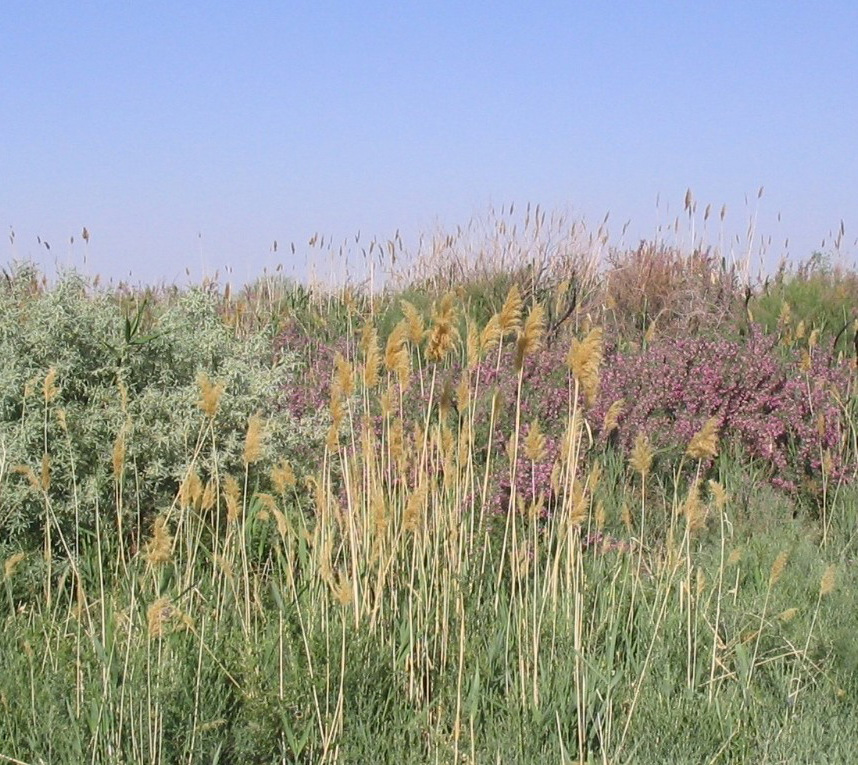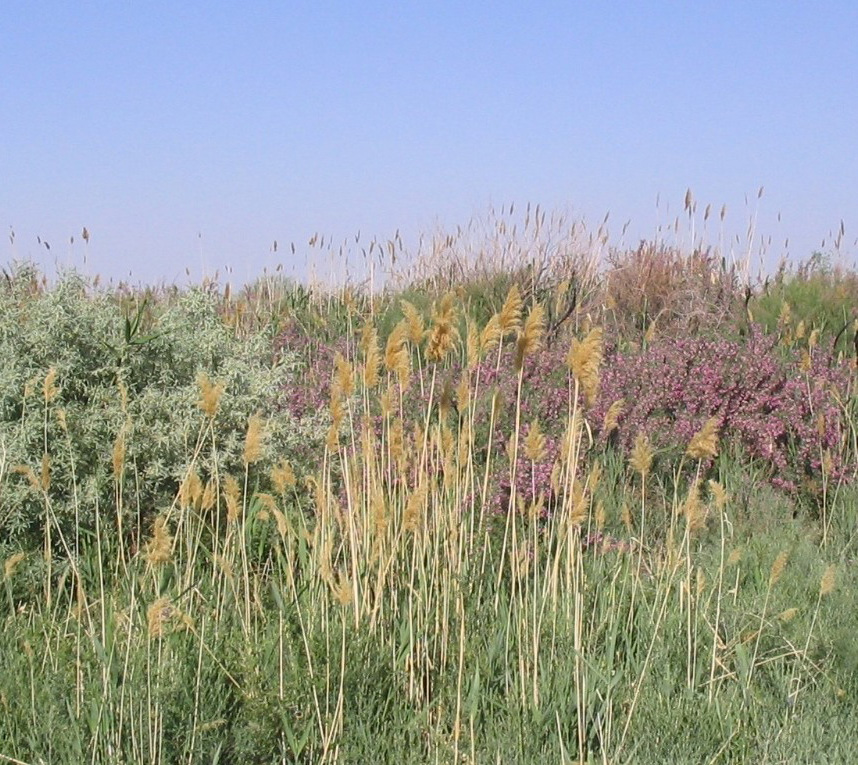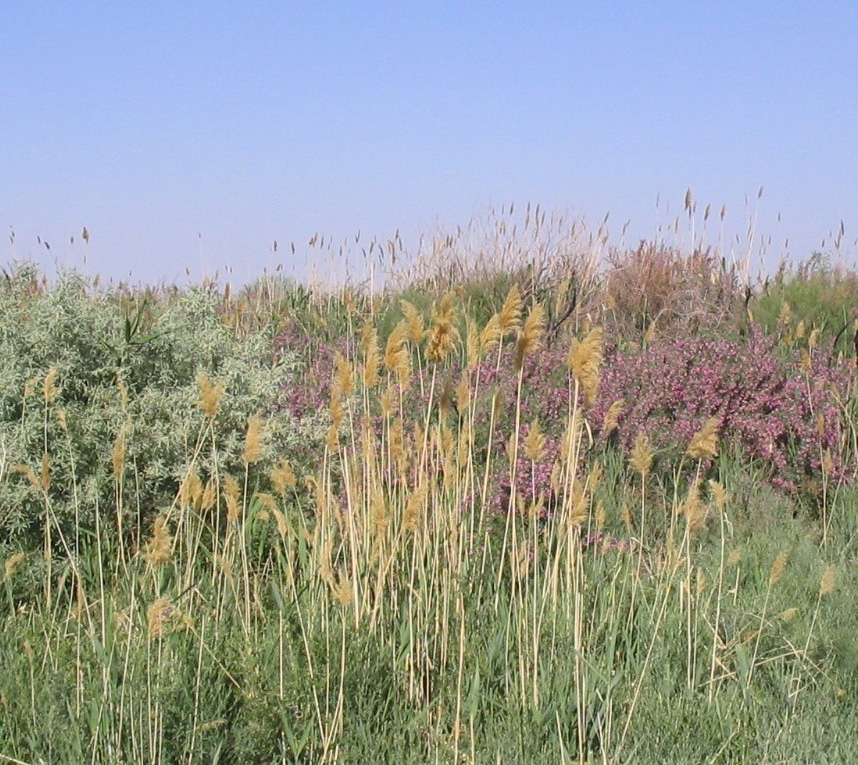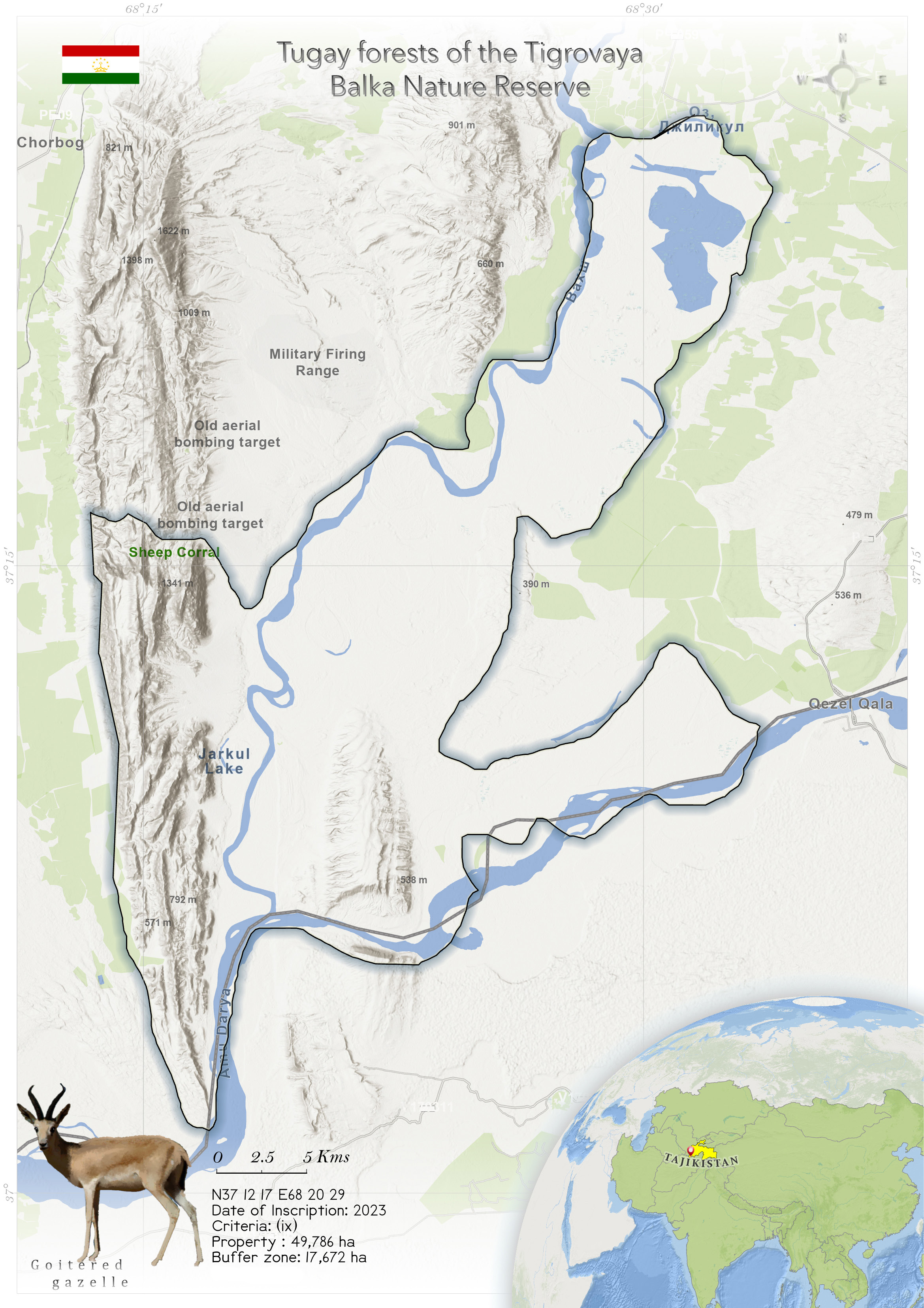
Tugay forests of the Tigrovaya Balka Nature Reserve (1685)
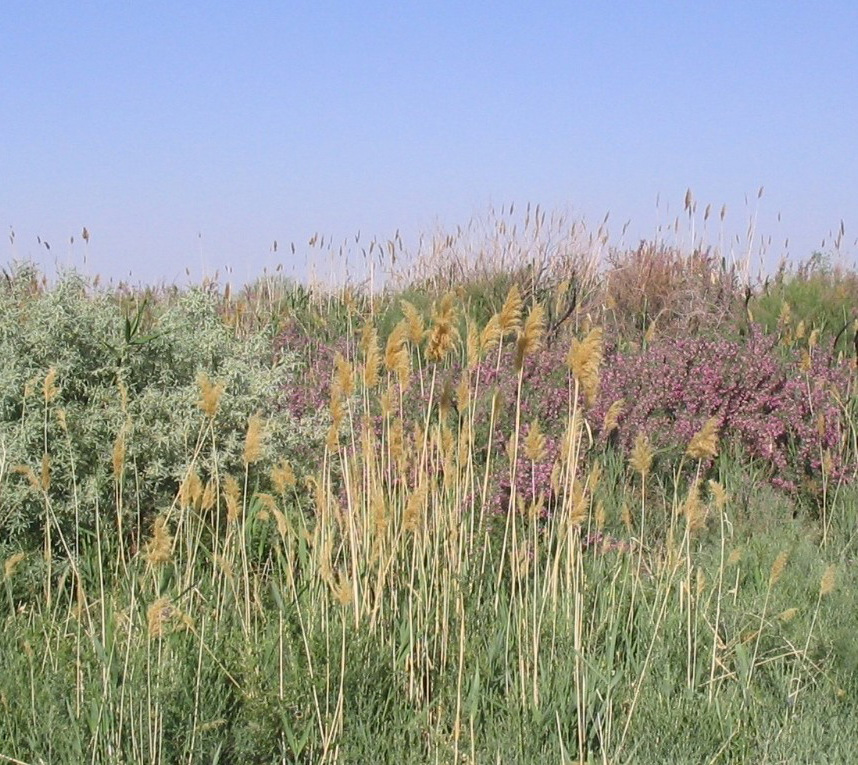 The Tugay forests of the Tigrovaya Balka Nature Reserve is nominated as a Word Heritage in the year of 2023. Located in Tajikistan, the area of the property is 49,786 hectares and the area of its buffer zone is 17,672 hectares. The designated area is situated within the interfluve region formed by the Vakhsh, Panj, and Kafirnigan rivers, adjacent to the Afghanistan border, where the Amu Darya, the largest river in Central Asia, originates. Encompassing extensive tugay ecosystems along the Vakhsh River, the area also includes the sandy terrain of the Kashka-Kum desert, the Buritau eminence, and the foothills of the southern Aruktau range known as the Hodja-Kaziyon mountains. The reserve is a unique desert-tugay reservation of dry Central Asian type subtropics, where a natural Asiatic poplar tugay vegetation complex is preserved. The Tigrovaya Balka Nature Reserve is a living memory of tugay forests, impenetrable thickets of trees and shrubs, which existed relatively recently on vast areas. The massif of Asiatic poplar tugay forests preserved here makes it possible to assess the current scale of anthropogenic impact on nature and evolution of landscapes of the planet as a whole. Asiatic poplar tamarix tugays, Asiatic poplar oleaster reed tugays, and Asiatic poplar licorice tugays correspond to tallgrass tugay types of lands with good protective properties and satisfy the wildlife of the reserve as a food base and a fauna habitat. Relict tugays belong to the desert type of land for wild fauna.
The Tugay forests of the Tigrovaya Balka Nature Reserve is nominated as a Word Heritage in the year of 2023. Located in Tajikistan, the area of the property is 49,786 hectares and the area of its buffer zone is 17,672 hectares. The designated area is situated within the interfluve region formed by the Vakhsh, Panj, and Kafirnigan rivers, adjacent to the Afghanistan border, where the Amu Darya, the largest river in Central Asia, originates. Encompassing extensive tugay ecosystems along the Vakhsh River, the area also includes the sandy terrain of the Kashka-Kum desert, the Buritau eminence, and the foothills of the southern Aruktau range known as the Hodja-Kaziyon mountains. The reserve is a unique desert-tugay reservation of dry Central Asian type subtropics, where a natural Asiatic poplar tugay vegetation complex is preserved. The Tigrovaya Balka Nature Reserve is a living memory of tugay forests, impenetrable thickets of trees and shrubs, which existed relatively recently on vast areas. The massif of Asiatic poplar tugay forests preserved here makes it possible to assess the current scale of anthropogenic impact on nature and evolution of landscapes of the planet as a whole. Asiatic poplar tamarix tugays, Asiatic poplar oleaster reed tugays, and Asiatic poplar licorice tugays correspond to tallgrass tugay types of lands with good protective properties and satisfy the wildlife of the reserve as a food base and a fauna habitat. Relict tugays belong to the desert type of land for wild fauna.
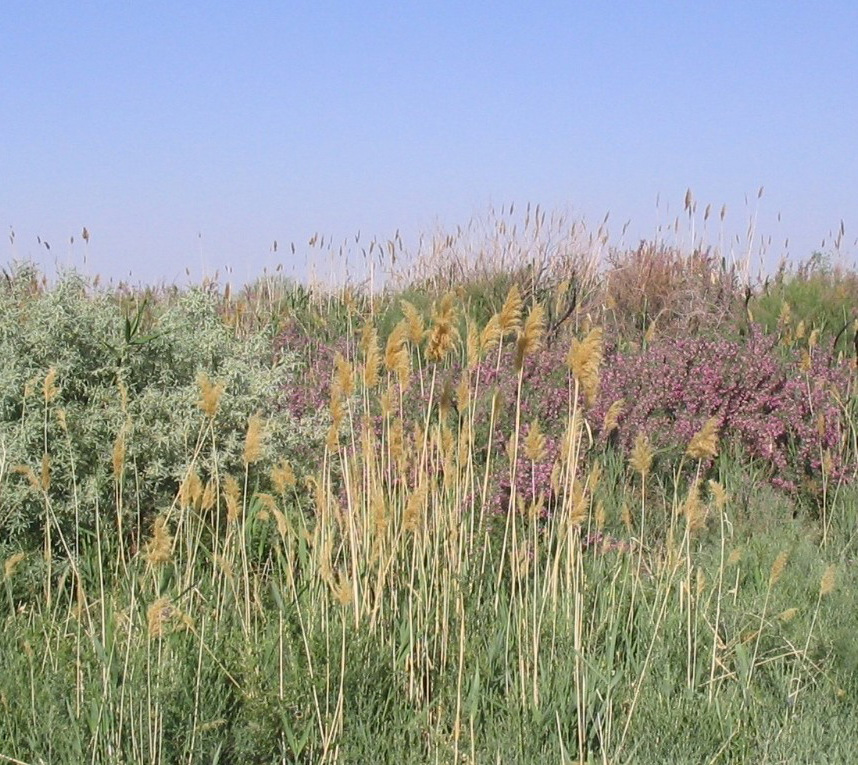 Located uniquely in the Southern Pamir-Alai and Hindu Kush mountain systems, where in the lower reaches of four large rivers (Panj, Vakhsh, Kafirnigan, Puli Khumri) hot climatic conditions with a huge wet mass on the surface of the earth and in a significant airspace were formed. It is here where mountain thorn and shrub woodland ecosystems are combined with desert sandy and wetland, savanoid ecosystems, and salt-tolerant tree-shrub communities with water resistant big sod grasses. This diversity of ecosystems has been preserved in the Tigrovaya Balka Nature Reserve since its creation in 1938. The reserve presents ecosystems of tugay floodplain forests, sandy and saline semi-deserts, foothill low- grass semi-savannas and wetlands, with the entire spectrum of flora and fauna representatives characteristic of them.
The climatic conditions in the Tigrovaya Balka Nature Reserve can be characterized by long hot summers, short winters, a large range of daily temperatures, and scarcity of precipitation during the cold season. Dusty southwestern winds, so-called ‘afghanets’, are not uncommon in Tigrovaya Balka. The complex is composed of water-resistant and thermophilic summer-green salt-tolerant trees and shrubs, such as the Asiatic poplar or blue poplar, the dzhida or oleaster, the multiramose tamarix, and rare and endangered animals inhabiting it, such as the Bactrian deer, whose population in the reserve exceeds 300 heads, the goitered gazelle, the striped hyena, the gray monitor, the Tajik black-and-gold pheasant, and many waterfowl birds. The hydrological network of the Tigrovaya Balka Nature Reserve is formed by the Panj and Vakhsh rivers and their tributaries. The main water artery is the Vakhsh, the basin of which occupies most of the nominated territory and plays a major role in the formation of its aquatic ecosystem (lakes, channels).
Being influenced by the water-salt regime of floodplains, which undergoes significant changes, tugay forests react to the behavior of the river. In their evolution, they pass through the stages of emergence, development, and decay. At the same time, their interrelation is traced by nomadic tugays that follow the river and are its derivatives. The type of tugay community is always a product of the system of its interaction with the river. The emergence of tugay forest stands is associated with fresh river sediments and is determined by the degree of moisture in the shallows and the mechanical composition of the sediment surface. Sandy loams and loamy soils, formed with a uniform decline in water, are the most optimal ones for the settlement of tugay vegetation.
Located uniquely in the Southern Pamir-Alai and Hindu Kush mountain systems, where in the lower reaches of four large rivers (Panj, Vakhsh, Kafirnigan, Puli Khumri) hot climatic conditions with a huge wet mass on the surface of the earth and in a significant airspace were formed. It is here where mountain thorn and shrub woodland ecosystems are combined with desert sandy and wetland, savanoid ecosystems, and salt-tolerant tree-shrub communities with water resistant big sod grasses. This diversity of ecosystems has been preserved in the Tigrovaya Balka Nature Reserve since its creation in 1938. The reserve presents ecosystems of tugay floodplain forests, sandy and saline semi-deserts, foothill low- grass semi-savannas and wetlands, with the entire spectrum of flora and fauna representatives characteristic of them.
The climatic conditions in the Tigrovaya Balka Nature Reserve can be characterized by long hot summers, short winters, a large range of daily temperatures, and scarcity of precipitation during the cold season. Dusty southwestern winds, so-called ‘afghanets’, are not uncommon in Tigrovaya Balka. The complex is composed of water-resistant and thermophilic summer-green salt-tolerant trees and shrubs, such as the Asiatic poplar or blue poplar, the dzhida or oleaster, the multiramose tamarix, and rare and endangered animals inhabiting it, such as the Bactrian deer, whose population in the reserve exceeds 300 heads, the goitered gazelle, the striped hyena, the gray monitor, the Tajik black-and-gold pheasant, and many waterfowl birds. The hydrological network of the Tigrovaya Balka Nature Reserve is formed by the Panj and Vakhsh rivers and their tributaries. The main water artery is the Vakhsh, the basin of which occupies most of the nominated territory and plays a major role in the formation of its aquatic ecosystem (lakes, channels).
Being influenced by the water-salt regime of floodplains, which undergoes significant changes, tugay forests react to the behavior of the river. In their evolution, they pass through the stages of emergence, development, and decay. At the same time, their interrelation is traced by nomadic tugays that follow the river and are its derivatives. The type of tugay community is always a product of the system of its interaction with the river. The emergence of tugay forest stands is associated with fresh river sediments and is determined by the degree of moisture in the shallows and the mechanical composition of the sediment surface. Sandy loams and loamy soils, formed with a uniform decline in water, are the most optimal ones for the settlement of tugay vegetation.
Criterion (ix)
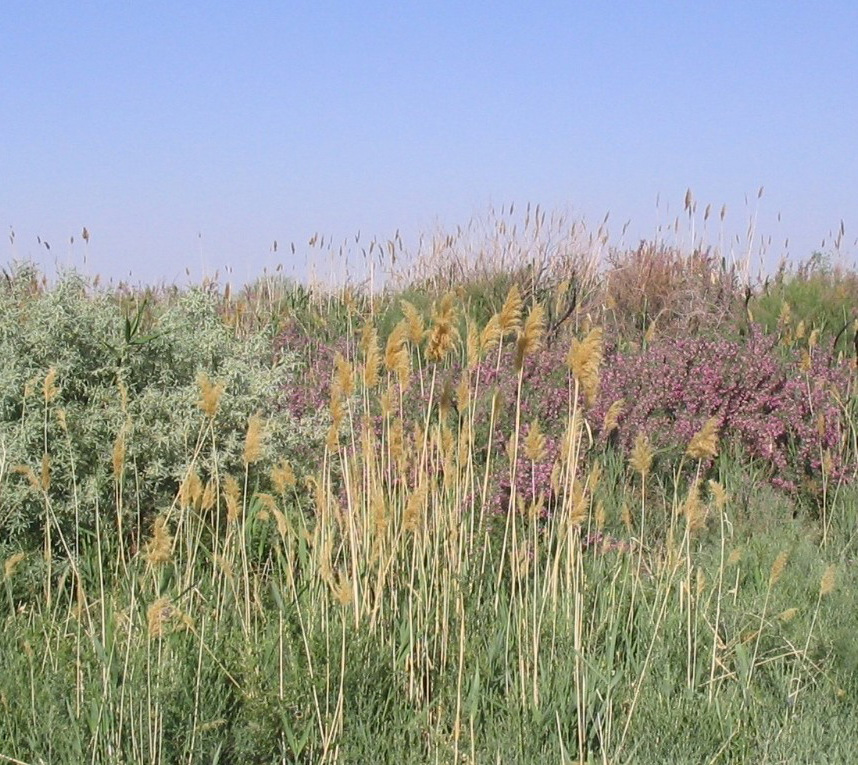 The natural complex of Tigrovaya Balka is an outstanding example of continuous ecological and biological processes taking place in the evolution and development of desert-tugay biocenoses and their characteristic plant and animal communities. The reserve hosts various ecological units, not only tugay lowland forests, but also steppe and semi-desert areas and their various ecotones where many stenoeceous species of flora are found. The reserve’s forests, sandy and saline semi-deserts, piedmont semi-savannas, and various wetlands are dynamically adapting to changes in the hydrological regime of the territory. There are several habitats in the reserve: tugay riverine forests, freshwater bodies and marshes, semi-deserts, takirs and solonchaks.
The complex features water-resistant and thermophilic, salt-tolerant trees and shrubs such as the Asiatic Poplar or Blue Poplar, the Dzhida or Oleaster, the Multiramose Tamarix. Wildlife includes Bactrian Deer, whose population in the reserve exceeds 300; Goitered Gazelle, Striped Hyena, Gray Monitor, Tajik Black-and-gold Pheasant, and many waterfowl, completing the largely intact tugay ecosystem. The 24,100 hectares of tugay forests in the reserve represent the largest and most intact tugay forest of this type in Central Asia, and this is the only place in the world where the Asiatic poplar tugay ecosystem has been preserved in its original state over an area of this size.
The natural complex of Tigrovaya Balka is an outstanding example of continuous ecological and biological processes taking place in the evolution and development of desert-tugay biocenoses and their characteristic plant and animal communities. The reserve hosts various ecological units, not only tugay lowland forests, but also steppe and semi-desert areas and their various ecotones where many stenoeceous species of flora are found. The reserve’s forests, sandy and saline semi-deserts, piedmont semi-savannas, and various wetlands are dynamically adapting to changes in the hydrological regime of the territory. There are several habitats in the reserve: tugay riverine forests, freshwater bodies and marshes, semi-deserts, takirs and solonchaks.
The complex features water-resistant and thermophilic, salt-tolerant trees and shrubs such as the Asiatic Poplar or Blue Poplar, the Dzhida or Oleaster, the Multiramose Tamarix. Wildlife includes Bactrian Deer, whose population in the reserve exceeds 300; Goitered Gazelle, Striped Hyena, Gray Monitor, Tajik Black-and-gold Pheasant, and many waterfowl, completing the largely intact tugay ecosystem. The 24,100 hectares of tugay forests in the reserve represent the largest and most intact tugay forest of this type in Central Asia, and this is the only place in the world where the Asiatic poplar tugay ecosystem has been preserved in its original state over an area of this size.
Status
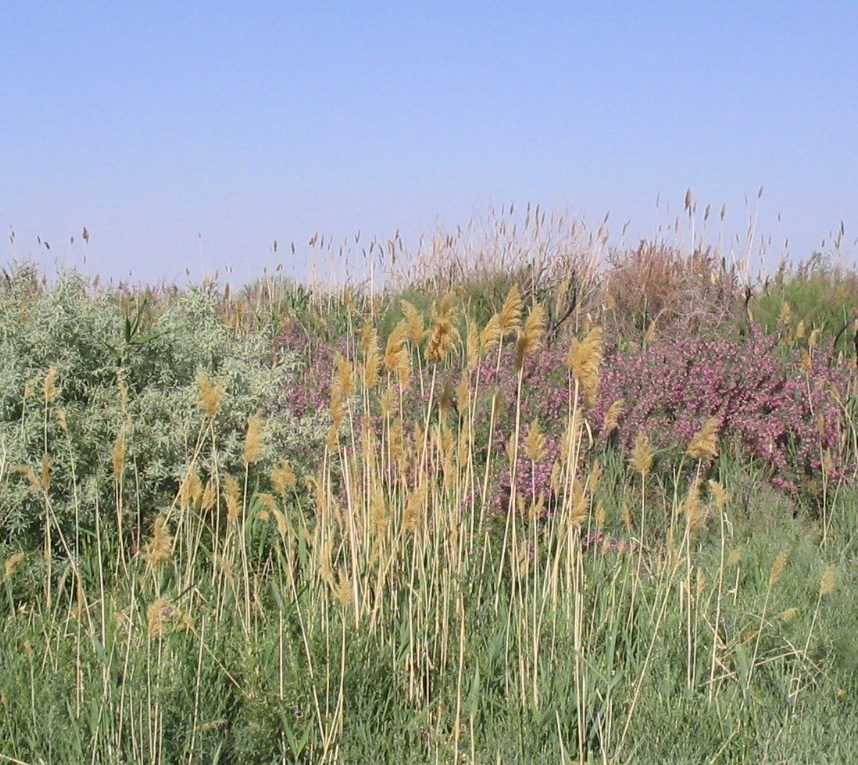 The Tigrovaya Balka Nature Reserve, created in 1938, is the largest reserve where the desert-tugay complex of the dry subtropical zone is preserved under natural conditions. Agriculture and cattle grazing are the main forms of economic activity in the areas adjacent to the reserve. The property has had the status of a state nature reserve since 1938, the highest nature protection status of Tajikistan. The integrity of the property depends on the riparian dynamics of the Vakhsh and Panj rivers, with the Vakhsh being the most important but also the most modified by eight dams. These dams change inter-seasonal and inter- annual flow dynamics reducing the flooding on which riparian tugay ecosystems depend. Only the section along the Panj river is still under some influence of natural riparian dynamics but their riparian woodlands are of limited size. In the context of the ongoing global climate change and an increase in aridity of the Pamir-Alai territory as a whole, in the coming years, there is a high probability of decrease in the number of springs, change in channel processes and dryingup of seasonal rivers. In the future, natural ecosystems may somewhat change their boundaries. It is assumed that the moisture supply of the territory will decrease due to a decrease in surface runoff.
The Tigrovaya Balka Nature Reserve, created in 1938, is the largest reserve where the desert-tugay complex of the dry subtropical zone is preserved under natural conditions. Agriculture and cattle grazing are the main forms of economic activity in the areas adjacent to the reserve. The property has had the status of a state nature reserve since 1938, the highest nature protection status of Tajikistan. The integrity of the property depends on the riparian dynamics of the Vakhsh and Panj rivers, with the Vakhsh being the most important but also the most modified by eight dams. These dams change inter-seasonal and inter- annual flow dynamics reducing the flooding on which riparian tugay ecosystems depend. Only the section along the Panj river is still under some influence of natural riparian dynamics but their riparian woodlands are of limited size. In the context of the ongoing global climate change and an increase in aridity of the Pamir-Alai territory as a whole, in the coming years, there is a high probability of decrease in the number of springs, change in channel processes and dryingup of seasonal rivers. In the future, natural ecosystems may somewhat change their boundaries. It is assumed that the moisture supply of the territory will decrease due to a decrease in surface runoff.

